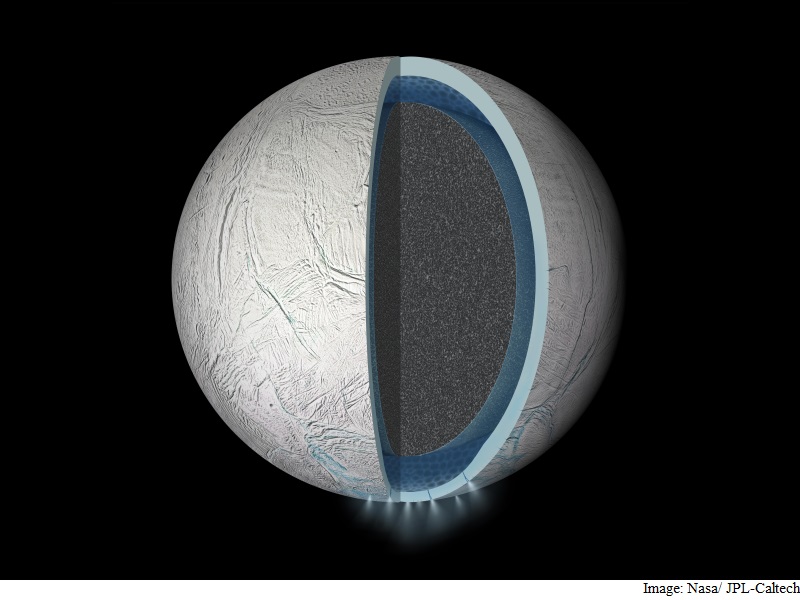- Home
- Science
- Science News
- Nasa's Cassini Probe Spots Global Ocean on Saturn's Moon Enceladus
Nasa's Cassini Probe Spots Global Ocean on Saturn's Moon Enceladus

Researchers found that the magnitude of the geologically active moon's very slight wobble, as it orbits Saturn, can only be accounted for if its outer ice shell is not frozen solid to its interior, meaning a "global ocean" must be present.
Previous analysis of Cassini data suggested the presence of a lens-shaped body of water, or sea, underlying the moon's south polar region.
However, gravity data collected during the spacecraft's several close passes over the south polar region lent support to the possibility the sea might be global.
"This was a hard problem that required years of observations, and calculations involving a diverse collection of disciplines, but we are confident we finally got it right," said Peter Thomas, Cassini imaging team member at Cornell University, Ithaca, New York, in a statement.
Cassini is scheduled to make a close flyby of Enceladus on October 28, in the mission's deepest-ever dive through the moon's active plume of icy material.
The spacecraft will pass a mere 49 kms above the moon's surface.
Earlier, Cassini scientists analysed more than seven years' worth of images of Enceladus taken by the spacecraft which has been orbiting Saturn since mid-2004.
They found Enceladus has a tiny, but measurable wobble as it orbits Saturn.
Because the icy moon is not perfectly spherical and because it goes slightly faster and slower during different portions of its orbit around Saturn the giant planet subtly rocks Enceladus back and forth as it rotates.
The team plugged their measurement of the wobble, called a libration, into different models for how Enceladus might be arranged on the inside, including ones in which the moon was frozen from surface to core.
"If the surface and core were rigidly connected, the core would provide so much dead weight the wobble would be far smaller than we observe it to be," explained Matthew Tiscareno, Cassini participating scientist at the SETI Institute in California.
"This proves that there must be a global layer of liquid separating the surface from the core," he added.
The mechanisms that might have prevented Enceladus' ocean from freezing still remain a mystery.
According to Thomas and his colleagues, tidal forces due to Saturn's gravity could be generating much more heat within Enceladus than previously thought.
The paper was published online in the journal Icarus.
Catch the latest from the Consumer Electronics Show on Gadgets 360, at our CES 2026 hub.
Related Stories
- Samsung Galaxy Unpacked 2025
- ChatGPT
- Redmi Note 14 Pro+
- iPhone 16
- Apple Vision Pro
- Oneplus 12
- OnePlus Nord CE 3 Lite 5G
- iPhone 13
- Xiaomi 14 Pro
- Oppo Find N3
- Tecno Spark Go (2023)
- Realme V30
- Best Phones Under 25000
- Samsung Galaxy S24 Series
- Cryptocurrency
- iQoo 12
- Samsung Galaxy S24 Ultra
- Giottus
- Samsung Galaxy Z Flip 5
- Apple 'Scary Fast'
- Housefull 5
- GoPro Hero 12 Black Review
- Invincible Season 2
- JioGlass
- HD Ready TV
- Laptop Under 50000
- Smartwatch Under 10000
- Latest Mobile Phones
- Compare Phones
- OPPO Reno 15 Pro Max
- Honor Win RT
- Honor Win
- Xiaomi 17 Ultra Leica Edition
- Xiaomi 17 Ultra
- Huawei Nova 15
- Huawei Nova 15 Pro
- Huawei Nova 15 Ultra
- Asus ProArt P16
- MacBook Pro 14-inch (M5, 2025)
- OPPO Pad Air 5
- Huawei MatePad 11.5 (2026)
- Xiaomi Watch 5
- Huawei Watch 10th Anniversary Edition
- Acerpure Nitro Z Series 100-inch QLED TV
- Samsung 43 Inch LED Ultra HD (4K) Smart TV (UA43UE81AFULXL)
- Asus ROG Ally
- Nintendo Switch Lite
- Haier 1.6 Ton 5 Star Inverter Split AC (HSU19G-MZAID5BN-INV)
- Haier 1.6 Ton 5 Star Inverter Split AC (HSU19G-MZAIM5BN-INV)

















